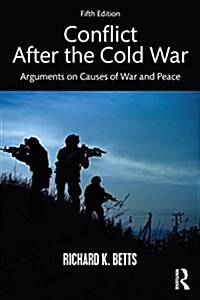
Conflict after the Cold War: arguments on causes of war and peace
- 개인저자
- Richard K. Betts
- 판사항
- Fifth edition
- 발행사항
- New York, NY; Abingdon, Oxon: Routledge, Taylor & Francis Group, 2017
- 형태사항
- xv, 666 p. : illustrations ; 24 cm
- ISBN
- 9781138290693
- 청구기호
- 349.81 B565c
- 서지주기
- Includes bibliographical references
소장정보
| 위치 | 등록번호 | 청구기호 / 출력 | 상태 | 반납예정일 |
|---|---|---|---|---|
이용 가능 (1) | ||||
| 1자료실 | 00017099 | 대출가능 | - | |
- 등록번호
- 00017099
- 상태/반납예정일
- 대출가능
- -
- 위치/청구기호(출력)
- 1자료실
책 소개
Edited by one of the most renowned scholars in the field, Richard Betts' Conflict After the Cold War assembles classic and contemporary readings on enduring problems of international security. Offering broad historical and philosophical breadth, the carefully chosen and excerpted selections in this popular reader help students engage key debates over the future of war and the new forms that violent conflict will take. Conflict After the Cold War encourages closer scrutiny of the political, economic, social, and military factors that drive war and peace.
New to the Fifth Edition:
- Original introductions to each of 10 major parts as well as to the book as a whole have been updated by the author.
- An entirely new section (Part IX) on "Threat Assessment and Misjudgment" explores fundamental problems in diagnosing danger, understanding strategic choices, and measuring costs against benefits in wars over limited stakes.
- 12 new readings have been added or revised:
Fred C. Ikle, "The Dark Side of Progress"
G. John Ikenberry, "China’s Choice"
Kenneth N. Waltz, "Why Nuclear Proliferation May Be Good"
Daniel Byman, "Drones: Technology Serves Strategy"
Audrey Kurth Cronin, "Drones: Tactics Undermine Strategy"
Eyre Crowe and Thomas Sanderson, "The German Threat? 1907"
Neville Henderson, "The German Threat? 1938"
Vladimir Putin, "The Threat to Ukraine from the West"
Eliot A. Cohen, "The Russian Threat"
James C. Thomson, Jr., "How Could Vietnam Happen? An Autopsy"
Stephen Biddle, "Afghanistan’s Legacy"
Martin C. Libicki, "Why Cyberdeterrence is Different"
목차
Preface
Part I. Visions of Conflict and Peace_____________________________________
- Francis Fukuyama, "The End of History?"
- John J. Mearsheimer, "Why We Will Soon Miss the Cold War"
- Samuel P. Huntington, "The Clash of Civilizations?"
- Fareed Zakaria, "Economics Trumps Politics"
- Fred C. Ikle, "The Dark Side of Progress"
Part II. International Realism: Anarchy and Power_____________________________
- Thucydides, "The Melian Dialogue"
- Niccolo Machiavelli, "Doing Evil in Order to Do Good"
- Thomas Hobbes, "The State of Nature"
- Edward Hallett Carr, "Realism and Idealism"
- Kenneth N. Waltz, "The Origins of War in Neorealist Theory"
- Robert Gilpin, "Hegemonic War and International Change"
- Geoffrey Blainey, "Power, Culprits, and Arms"
Part III. International Liberalism: Institutions and Cooperation_______________
- Immanuel Kant, "Perpetual Peace"
- Richard Cobden, "Peace Through Arbitration"
- Woodrow Wilson, "Community of Power vs. Balance of Power"
- Michael W. Doyle, "Liberalism and World Politics"
- Robert O. Keohane and Joseph S. Nye, "Power and Interdependence"
- John Mueller, "The Obsolescence of Major War"
Part IV. Psychology and Culture: The Human Mind, Norms, and Learning________
- Sigmund Freud, "Why War?"
- Stanley Milgram, "How Good People Do Bad Things"
- Robert Jervis, "War and Misperception"
- Richard Ned Lebow, "Spirit, Standing, and Honor"
- Margaret Mead, "War is Only an Invention, Not a Biological Necessity"
- J. Ann Tickner, "Men, Women, and War"
Part V. Economics: Interests and Interdependence__________________
- Niccolo Machiavelli, "Money is Not the Sinews of War..."
- Norman Angell, "The Great Illusion"
- Geoffrey Blainey, "Paradise is a Bazaar"
- V.I. Lenin, "Imperialism, the Highest Stage of Capitalism"
- Joseph Schumpeter, "Imperialism and Capitalism"
- Alan S. Milward, "War as Policy"
- Kenneth N. Waltz, "Structural Causes and Economic Effects"
- Richard Rosecrance, "Trade and Power"
- G. John Ikenberry, "China’s Choice"
Part VI. Politics: Ideology and Identity_____________________________
- Edward Mansfield and Jack Snyder, "Democratization and War"
- Ernest Gellner, "Nations and Nationalism"
- Chaim Kaufmann, "Possible and Impossible Solutions to Ethnic Civil Wars"
- Radha Kumar, "The Troubled History of Partition"
Part VII. Military Technology, Strategy, and Stability__________________
- Robert Jervis, "Cooperation Under the Security Dilemma"
- Jack S. Levy, "The Offensive/Defensive Balance of Military Technology"
- Kenneth N. Waltz, "Why Nuclear Proliferation May Be Good"
- Daniel Byman, "Drones: Technology Serves Strategy"
- Audrey Kurth Cronin, "Drones: Tactics Undermine Strategy"
Part VIII. Terrorism, Revolution, and Unconventional Warfare________
- Martha Crenshaw, "The Logic of Terrorism"
- Osama bin Ladin, "Speech to the American People"
- T. E. Lawrence, "Science of Guerrilla Warfare"
- Mao Tse-tung, "On Guerrilla Warfare"
- Samuel P. Huntington, "Patterns of Violence in World Politics"
- David Galula, "Insurgency and Counterinsurgency"
- Eliot Cohen, Conrad Crane, Jan Horvath, and John Nagl, "Principles, Imperatives, and Paradoxes of Counterinsurgency"
- Gian P. Gentile, "A Strategy of Tactics: The Folly of Counterinsurgency"
Part IX. Threat Assessment and Misjudgment: Recurrent Dilemmas
- Eyre Crowe and Thomas Sanderson, "The German Threat? 1907"
- Neville Henderson, "The German Threat? 1938"
- Vladimir Putin, "The Threat to Ukraine from the West"
- Eliot A. Cohen, "The Russian Threat"
- James C. Thomson, Jr., "How Could Vietnam Happen? An Autopsy"
- Stephen Biddle, "Afghanistan’s Legacy"
- Richard K. Betts and Thomas J. Christensen, "China: Can the Next Superpower Rise Without War?"
Part X. New Threats and Strategies for Peace______________________
- Thomas F. Homer-Dixon, "Environmental Changes as Causes of Acute Conflict"
- Martin C. Libicki, "Why Cyberdeterrence is Different"
- G. John Ikenberry and Anne-Marie Slaughter, "A World of Liberty Under Law"
- Samuel P. Huntington, "Peace Among Civilizations?"

